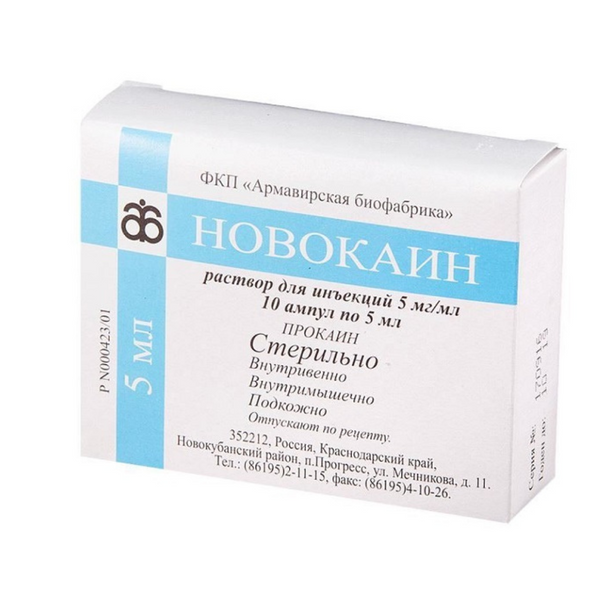|
Quantity
|
Out of stock
|
||
|
|
|||
Storage
1 ml of the drug contains:
novocaine - 5 mg
Description
The solution is colorless, transparent.
Pharmacological properties
Means for local anesthesia with moderate activity and a wide spectrum of therapeutic action. Blocks sodium channels, inhibits the penetration of potassium, reduces the tension of the phospholipid layer of cell membranes, inhibits redox processes and the generation of nerve impulses. When entering the blood, it reduces the formation of acetylcholine, the excitability of peripheral cholinergic systems, spasms of smooth muscles, the excitability of the heart muscle and motor areas of the cerebral cortex, blocks the autonomic ganglia.
It is well absorbed when administered parenterally. The degree of absorption depends on the site, method of administration and dose. It is quickly hydrolyzed by esterases and cholinesterases of blood plasma and tissues with the formation of two main pharmacologically active metabolites: diethylaminoethanol, which provides an anesthetic and moderate vasodilator effect, and paraaminobenzoic acid, which is a component of folic acid, has an antihistamine effect, participates in detoxification processes and is an antagonist of sulfonamides drugs
The half-life of novocaine is 30-50 seconds, in the neonatal period - 54-114 seconds. It is excreted mainly by the kidneys in the form of metabolites (80%) and in unchanged form (maximum 2%).
Indication
It is used for infiltration anesthesia as an anesthetic and anticonvulsant in combination with specific and symptomatic drugs for stomach ulcers, atony of the antrum and intestines, dyspepsia, spastic colic, intestinal obstruction, peritonitis, reticuloperitonitis, bronchopneumonia, catarrhal pneumonia, hyperemia, pulmonary edema, uterine prolapse, vagina or rectum, metritis, fecal retention, serous catarrhal mastitis, rheumatic hoof inflammation, pododermatitis, inflammation of muscles and joints, with slowly granulating wounds, ulcers, fistulas, myositis, papillomatosis.
It is used as a chemotherapeutic drug for carrying out novocaine blockades, as well as for dissolving antibiotics in order to anesthetize the injection site and prolong their effect.
Contraindication
Do not prescribe to animals with increased sensitivity to novocaine.
Do not enter in places with hypotension and purulent processes.
Method of application and dosage
Before use, the drug is heated to the temperature of the animal's body and administered subcutaneously, intramuscularly, intravenously or intra-aortically.
The maximum single doses per 1 animal are:
horses — 400-500 ml;
cattle - 300-400 ml;
goats, sheep, pigs — 100-150 ml;
dogs — 60-100 ml.
Reservation
Administer the drug intravenously slowly!
Intravenous injections of the drug in maximum doses cause excitement, muscle tremors, which gradually turn into clinical convulsions.
Novocaine strengthens positive conditioned reflexes and weakens inhibition. After a period of excitement comes a period of depression, slowing of breathing and cardiac activity. In case of non-fatal poisoning, intoxication of the body continues, and the residual effects disappear after a day. To relieve excitement during poisoning, short-acting barbiturates should be administered intravenously, and oxygen (inhalation and subcutaneous) should be used to eliminate hypoxia.
The drug weakens the antimicrobial effect of sulfonamides and enhances the effect of drugs for general anesthesia.
Incompatible with tanids, alkalis, oxidizers, salts of heavy metals, hexamethylenetetramine (urotropin), sulfonamides. The latter weaken the anesthetic effect of novocaine. When mixing novocaine with caffeine, sodium benzoate or amidopyrine, which have an alkaline reaction, a neutralization reaction occurs.
Storage conditions
In a dry, dark place at temperatures from +3 to +25 °C.
After opening the ampoule, the drug should be used immediately, after opening the bottle, the drug should be stored in the refrigerator and used within 7 days.
Expiration date
3 years.
































